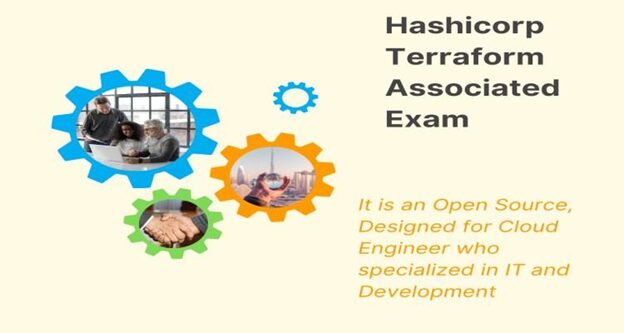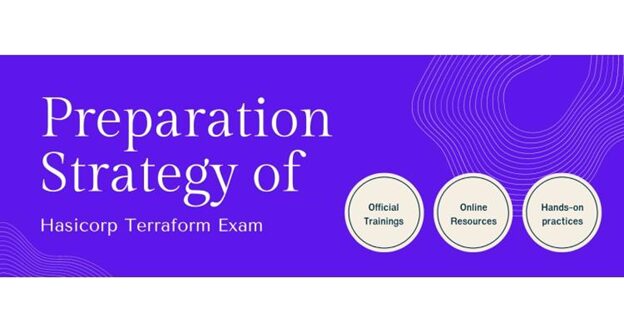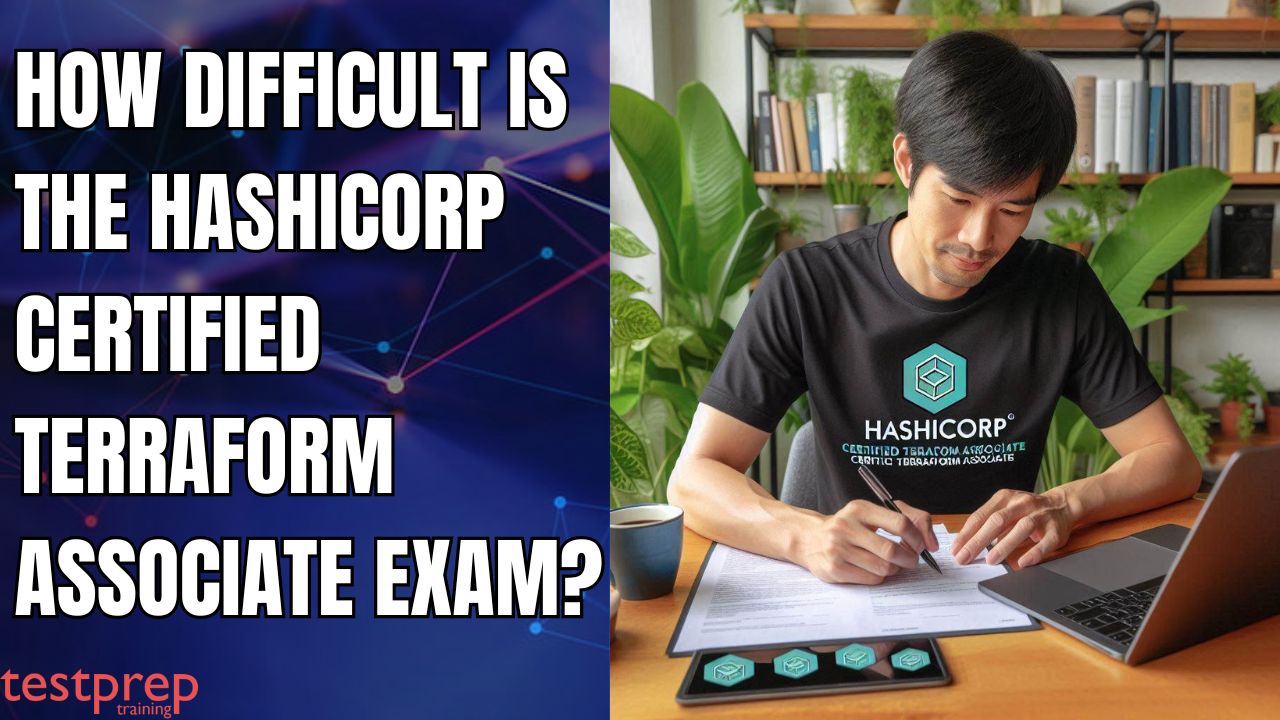The Hashicorp Terraform Associate Certification is an open-source project for Cloud engineers who focus on IT, operations, and development and who are familiar with the core concepts and features of Hashicorp Terraform. Setting up information technology (IT) infrastructure across several clouds and environments can sometimes become challenging and complex. Using Terraform or another infrastructure-as-a-code (IaC) solution is ideal for organizations to manage and scale their infrastructure. The difficulty level of the Hashicorp certified Terraform associate exam varies according to the person’s background with Terraform and knowledge of infrastructures as code (IaC) concepts.
What is Terraform
It is an Open-source infrastructure as a code tool created by HashiCorp. Users of Terraform can also manage low-level components like networking, storage, and compute resources as well as high-level components like SaaS service and DNS records. Another benefit of Terraform is that it can scale or delete resources as needed. Running the terraform command additional resources may be simple,it eliminates every resource in your configuration. With the help of Terraform, businesses may simplify their management process.
What Makes Terraform Useful:
Terraform is employed in:
1. Setting up necessary infrastructure
With the use of application programming interfaces (APIs), you can communicate with cloud platforms and other services using Terraform’s plugins or providers. HashiCorp and Terraform community have produced a plethora of providers for managing resources of AWS, Azure,GCP, Kubernetes, Helm, GitHub, Splunk and DataDog among others
2. Creating a uniform deployment process
Individual infrastructure components, such as computing instances or private networks are specified by providers in Terraform as resources. On the other hand, you can generate resources from other sources into modules-Reusable Terraform setups. Next, handle them with a standardized language and procedure.
Moreover, declarative configuration is used in Terraform. That is unlike procedural programming, it describes the intended end-state for your architecture languages that require detailed instructions to complete activities.Resources can be produced or deleted in the correct order by using Terraform providers ability to automatically identify resource dependencies.
3. Monitoring your system
Terraform serves as a source of truth for your environment by continuously recording real infrastructure in a state file. Additionally it uses the state file to figure out what changes your infrastructure needs to make in order to make your configuration.
4. Working together
With the Terraform remote state backends teamwork on your infrastructure is made easier. On the other hand, you can safely share your teammate’s states while utilizing Terraform Cloud, which keeps Terraform operating in a stable environment. Additionally it avoids racial situations where numerous individuals alter configuration simultaneously

Understanding the Certified Terraform Associate Exam
The Certified Terraform Associate exam is designed to validate your understanding of the fundamental concepts and skills associated with HashiCorp Terraform, a popular Infrastructure as Code (IaC) tool used to manage cloud and on-premises infrastructure. The exam assesses your knowledge of core Terraform concepts, including configuration files, modules, state management, and resource provisioning. It requires you to demonstrate your ability to write and execute Terraform code, understand Terraform’s workflow, and troubleshoot common issues.
You’ll also be expected to know about Terraform Enterprise features and how they differ from the Community Edition. While not strictly required, practical experience using Terraform in a production environment is highly recommended to prepare for the exam.
Exam Format
- The test will be administered using multiple-choice questions.
- The certification exam lasts for one hour.
- Although the exact number of questions is unknown, it is estimated to be between 50 and 60, though this could change depending on Hashicorp does not formally disclose the passing score of 70%
- The English language alone will be utilized to administer the exam.
- Although the exam does not assess hands-on familiarity with Terraform tools in great detail.
- It does call for a basic knowledge of how to set up Terraform in an organization.
- The exam validation period is two years from the date of certification issue.
- Approximately 10 days are needed to obtain the digital certification badge.
Assessing the Difficulty of the HashiCorp Certified Terraform Associate Exam
The HashiCorp Certified Terraform Associate exam is designed to evaluate your understanding of the fundamental concepts and skills associated with Terraform, a popular Infrastructure as Code (IaC) tool. While it’s not considered one of the most challenging certification exams, its difficulty can vary depending on several factors. Experience with Terraform plays a significant role in determining how challenging you’ll find the exam. If you’ve been using Terraform for a considerable amount of time and have a solid grasp of its core concepts, you’ll likely find the exam easier. Additionally, a general understanding of Infrastructure as Code principles can also be beneficial.
Preparation is another crucial factor. Utilizing official HashiCorp documentation, practice exams, and training courses can significantly improve your chances of success. Hands-on practice with Terraform, including building modules and managing infrastructure, is also essential for consolidating your understanding. The exam objectives focus on foundational Terraform concepts, such as configuration files, modules, state management, and resource provisioning. Additionally, understanding Terraform Enterprise features and their differences from the Community Edition can be helpful.
Other Things to Consider:
A. Knowledge and Experience level
- Beginners level: the exam may be difficult for people who are unfamiliar with Terraform or infrastructure as code. It’s essential to understand infrastructure management and fundamental cloud computing concepts.
- Intermediate : The exam will be somewhat difficult for people who have some Terraform experience. The real challenge is learning Terraform’s quirks and best practices.
- Expert Users: If one uses Terraform frequently in their daily work, the exam might not be as difficult. All exam goals must be understood, though and practicing various scenarios is still essential.
B. Key challenges
- Understanding the state File: Terraform focuses largely on the state file, and the state management issues could be complex. Understanding effective state management particularly remote state and state locking is essential.
- Managing Errors and Troubleshooting: An essential exam skill is the ability to troubleshoot and debug Terraform configuration problems.
- Best practices: Your knowledge of Terraform usage best practices, such as how to organize configurations and make efficient use of modules, is tested on the exam.
- Terraform Cloud and Enterprise: It can be difficult to comprehend the capabilities and applications of Terraform Cloud and Enterprise, particularly for individuals who utilize the open-source version exclusively.
Preparation Strategy for Certified Terraform Associate Exam

Preparing for the Hashicorp Certified Associate exam requires a comprehensive understanding of Terraform concepts, Hands-on-practice, and familiarity with the exam format. Here’s a detailed preparation strategy to help you succeed.
Step 1: Understanding the Exam Objectives
The Certified Terraform Associate exam is designed to evaluate your understanding of the fundamental concepts and skills associated with Terraform. To effectively prepare for the exam, it’s crucial to have a clear understanding of the specific objectives that will be assessed. The exam objectives cover a wide range of topics related to Terraform, including:
- Understand infrastructure as code (IaC) concepts
- Understand Terraform’s purpose (vs other IaC)
- Terraform basics
- Use the Terraform CLI (outside of core workflow)
- Interact with Terraform modules
- Navigate Terraform workflow
- Implement and maintain state
- Read, generate, and modify the configuration
- Understand Terraform Cloud and Enterprise capabilities
Step 2: Utilizing Study Resources
The official resources provided by HashiCorp are invaluable tools for preparing for the Certified Terraform Associate exam. These resources offer comprehensive guidance, practical examples, and in-depth explanations of Terraform concepts. By effectively utilizing these resources, you can build a strong foundation and enhance your understanding of Terraform. Here are some key official resources to use:
1. Terraform Documentation:
The Terraform documentation serves as a comprehensive reference for all aspects of Terraform, from basic concepts to advanced features. The documentation includes numerous examples and code snippets to illustrate how to use Terraform effectively. Explore the documentation for specific providers to learn about the resources and options available for different cloud platforms and infrastructure components.
2. HashiCorp Learn:
HashiCorp Learn offers interactive tutorials that guide you through various Terraform concepts and tasks. The tutorials often include hands-on exercises to reinforce your learning and gain practical experience. Follow curated learning paths to cover specific topics or prepare for the Certified Terraform Associate exam.
3. Terraform Enterprise Documentation:
If you’re working with Terraform Enterprise, explore the documentation to understand the additional features and capabilities it offers. Learn about best practices for using Terraform Enterprise, such as managing teams, controlling access, and implementing governance policies.
4. Terraform Community:
Engage with the Terraform community on forums and discussion boards to ask questions, seek help, and share your knowledge. Benefit from the expertise and experiences of other Terraform users. Contribute to the community by answering questions and providing valuable insights.
Step 3: Practice with Hands-On Exercises
Hands-on practice is essential for mastering Terraform and preparing for the Certified Terraform Associate exam. By actively working with Terraform, you can reinforce your understanding of concepts, develop practical skills, and identify areas where you may need further study. Here are some hands-on exercises to incorporate into your preparation:
1. Build Terraform Modules:
- Create reusable modules for common infrastructure components, such as virtual machines, networks, and storage.
- Experiment with different module parameters and configurations.
- Learn how to pass variables and data to modules.
2. Manage Infrastructure:
- Use Terraform to provision and manage various infrastructure resources, such as:
- Virtual machines on different cloud providers (AWS, Azure, GCP)
- Networks (VPCs, subnets, security groups)
- Storage (S3 buckets, EBS volumes)
- Databases (RDS, Cloud SQL)
- Experiment with different resource configurations and options.
3. Troubleshoot Common Issues:
- Practice troubleshooting common Terraform errors and challenges, such as:
- Configuration syntax errors
- State management issues
- Resource provisioning failures
- Learn how to use Terraform’s debugging tools and logs to identify and resolve problems.
4. Experiment with Advanced Features:
- Explore advanced Terraform features, such as:
- Custom providers
- Terraform Cloud and Enterprise
- Terraform Modules Registry
- Experiment with these features to understand their capabilities and how they can be used in your infrastructure management.
Step 4: Utilize Practice Exams
Practice exams are an invaluable tool for assessing your knowledge and identifying areas where you may need to improve before taking the Certified Terraform Associate exam. By simulating the exam environment and providing feedback on your performance, practice exams can help you develop effective exam-taking strategies and boost your confidence. Here are some tips for utilizing practice exams effectively:
1. Find Reputable Practice Exams:
- Look for practice exams from reputable sources, such as online training platforms or exam preparation companies.
- Ensure that the practice exams are aligned with the official exam objectives and cover a wide range of topics.
2. Practice Under Simulated Conditions:
- Take practice exams in a quiet environment, free from distractions.
- Time yourself to simulate the actual exam conditions and practice efficient time management.
3. Analyze Your Results:
- Carefully review your answers and identify any areas where you struggled.
- Analyze the explanations provided for incorrect answers to understand the underlying concepts.
4. Identify Weaknesses:
- Use practice exams to identify your areas of weakness and focus your studies accordingly.
- Prioritize topics that you find challenging or where you consistently make mistakes.
5. Practice Exam-Taking Strategies:
- Develop effective exam-taking strategies, such as:
- Skimming through the exam questions first to get an overview
- Answering easier questions first to build confidence
- Managing your time effectively to ensure you complete the exam
- Using the process of elimination to narrow down your options
6. Review and Improve:
- After taking a practice exam, review your performance and identify areas for improvement.
- Re-study the topics where you struggled and practice additional exercises.
Step 5: Join Online Communities
Engaging with the Terraform community online can provide valuable support, resources, and insights as you prepare for the Certified Terraform Associate exam. By connecting with other Terraform users, you can learn from their experiences, seek help when needed, and contribute to the community. Here are some ways to join online communities:
1. Terraform Forums:
- Visit the official Terraform forums to ask questions, seek help, and participate in discussions.
- Search for existing threads related to your specific questions or topics of interest.
- Contribute to the community by answering questions and sharing your knowledge.
2. Social Media Groups:
- Join Terraform-related groups on social media platforms like LinkedIn, Facebook, and Reddit.
- Participate in discussions, share resources, and connect with other Terraform enthusiasts.
3. Online Courses and Platforms:
- Many online courses and platforms offer discussion forums or communities where you can interact with other students and instructors.
- Participate in discussions, ask questions, and share your experiences with others.
4. Terraform Meetups:
- Attend local Terraform meetups to connect with other Terraform users in person.
- Network with professionals in the field and learn about the latest trends and best practices.
5. Contribute to Open-Source Projects:
- Contribute to open-source Terraform projects to gain practical experience and showcase your skills.
- Collaborate with other developers and learn from their contributions.
Step 6: Create a Study Plan
There is always a strategy needed for exams, and this one is no exception. A well-structured study plan is essential for effective preparation and success in the Certified Terraform Associate exam. By breaking down the exam objectives into smaller, achievable goals and allocating dedicated study time, you can ensure that you cover all the necessary topics and build a strong foundation.
1. Assess Your Current Knowledge:
- Evaluate your existing knowledge of Terraform concepts and identify areas where you may need to focus your studies.
- Take a practice exam to get a baseline assessment of your understanding.
2. Break Down the Exam Objectives:
- Divide the exam objectives into smaller, more manageable topics.
- Create a detailed study schedule that allocates time to each topic based on your current knowledge and the time available.
3. Gather Study Materials:
- Collect all the necessary study materials, including:
- Official Terraform documentation
- HashiCorp Learn tutorials
- Practice exams
- Online resources and forums
4. Allocate Study Time:
- Set aside dedicated study time each day or week, depending on your availability and learning style.
- Create a study schedule that fits your routine and allows for regular review.
5. Prioritize Topics:
- Focus on areas where you feel less confident or have identified weaknesses.
- Prioritize topics that are heavily weighted in the exam.
6. Active Learning Techniques:
- Use active learning techniques, such as:
- Taking notes
- Creating flashcards
- Teaching concepts to others
- Practicing hands-on exercises
7. Review Regularly:
- Regularly review your notes and study materials to reinforce your learning.
- Create a spaced repetition schedule to gradually reinforce concepts over time.
8. Practice with Mock Exams:
- Take practice exams regularly to assess your progress and identify areas for improvement.
- Analyze your performance to understand your strengths and weaknesses.
9. Stay Motivated:
- Set achievable goals and reward yourself for progress.
- Find a study buddy or join a study group for support and accountability.
- Stay positive and believe in your ability to succeed.
Conclusion
Conclusion
By effectively utilizing the strategies outlined in this guide, you can increase your chances of success in the Certified Terraform Associate exam. Remember to focus on understanding the exam objectives, leveraging official resources, practicing with hands-on exercises, utilizing practice exams, joining online communities, and creating a comprehensive study plan. The Hashicorp Certified Terraform Exam is an important certification for cloud and DevOps professionals. The level of difficulty can change according to your past knowledge and experience, and an exact understanding of Terraform’s fundamental ideas.it is the key to pass the exam it’s not just memorizing facts but understanding how to apply in the real-world scenarios.
With dedication and the right resources, you can conquer the Terraform certification and take a significant leap forward in your career. Good luck with your exam preparation.


